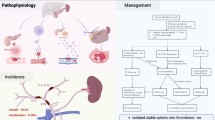Abstract
An episode of gastroenteritis triggered severe necrosis of all extremities in a previously asymptomatic male. Hepatic and renal involvement were also manifest, while the hematological picture was one of thrombotic microangiopathic hemolytic anemia. Antiphospholipid antibodies were negative. He responded well to a combination of plasma exchange, anticoagulation (heparin), parenteral steroids, and antibiotics, as well as vasodilators (prostacycline) and hyperbaric oxygen, but died because of a cerebral hemorrhage. The differential diagnosis included thrombotic thrombocytopenic purpura/hemolytic–uremic syndrome, or seronegative catastrophic antiphospholipid (Asherson’s) syndrome. The dangers of administering such a combination of therapies with anticoagulation, as well as vasodilatation (prostacycline) and hyperbaric oxygen, are highlighted by the case report and emphasized.

Similar content being viewed by others
References
Symmers W (1952) Thrombotic microangiopathic haemolytic anemia (thrombotic microangiopathy). BMJ 2:897–903
Espinosa G, Bucciarelli S, Cervera R et al (2004) Thrombotic microangiopathic hemolytic anemia and antiphospholipid antibodies. Ann Rheum Dis 63(6):730–736
Asherson RA (1992) The catastrophic antiphospholipid syndrome. J Rheumatol 19:508–512
Cervera R, Khamashta MA, Font J et al (1993) Systemic lupus erythematosus: clinical and immunological patterns of disease expression in a cohort of 1,000 patients. The European working party on systemic lupus erythematosus. Medicine (Baltimore) 72:113–124
Galbusera M, Noris M, Remuzzi G (2006) Thrombotic thrombocytopenic purpura—then and now. Semin Thromb Hemost 32(2):81–89
Tsai HM (2006) The molecular biology of thrombotic microangiopathy. Kidney Int 70:16–23, DOI 10.1038/sj.ki 5001535
McInyk AMS et al (1995) Adult hemolytic–anemic syndrome: a review of 37 cases. Arch Intern Med 155:2007
Fujisaki K, Masutani K, Yoshimitsu T et al (2005) Thrombotic thrombocytopenic purpura associated with polyarteritis nodosa. Clin Nephrol 64(4):305–310
Goodnight SH, Hathaway WE (2001) Disorders of hemostasis and thrombosis. A clinical guide, 2nd edn. McGraw Hill, New York, pp 271–279
Dang CT, Magid MS, Weksler B, Chadburn A, Laurence J (1999) Enhanced endothelial cell apoptosis in splenic tissues of patients with thrombotic thrombocytopenic purpura. Blood 93:1264–1270
Mitra D, Jaffe EA, Weksler B, Hajjar KA, Soderland C, Laurence J (1997) Thrombotic thrombocytopenic purpura and sporadic hemolytic uremic syndrome plasmas induce apoptosis in restricted lineages of human microvascular endothelial cells. Blood 89:1224–1234
Bowen DJ, Collins PW (2006) Insights into von Willebrand factor proteolysis: clinical implications. Br J Haematol 133(5):457–467
Tsai HM, Raoufi M, Zhou W et al (2006) ADAMTS 13 -binding IgG are present in patients with thrombotic thrombocytopenic purpura. Am J Clin Pathol 125:592–597
Morrin MJ, Jones FG, McConville J et al (2006) Thrombotic thrombocytopenic purpura secondary to Streptococcus. Transfus Apheresis Sci 34:153–155
Ardiles LG, Olavarria F, Elgueta M, Moya P, Mezzano S (1998) Anticardiolipin antibodies in classic pediatric hemolytic–uremic syndrome: a possible pathogenic role. Nephron 78:278–283
von Tempelhoff GF, Heilmann L, Spanuth E, Kunzmann E, Hommel G (2000) Incidence of the factor V Leiden-mutation, coagulation inhibitor deficiency, and elevated antiphospholipid-antibodies in patients with preeclampsia or HELLP syndrome. Thromb Res 100:363–365
Khamashta MA, Hughes GRV (2003) Seronegative APS. Ann Rheum Dis 62:1127
Asherson RA, Cervera R, Merrill JT (2006) Thrombotic microangiopathic antiphospholipid syndromes: a continuum of conditions? Future Rheumatol 1:1–10
Merrill JT, Asherson RA (2006) Catastrophic antiphospholipid syndrome nature clinical practice. Rheumatology 2:81–89
Asherson RA (2005) Multiorgan failure and antiphospholipid antibodies: the catastrophic antiphospholipid (Asherson’s ) syndrome. Immunobiology 210(10):727–733
McCarty GA (2000) Seronegative APS (SNAPS) in 53 patients. Seroconversion rate at 3.5 years. J Autoimmun 15 OC35, A13
Fontana S, Kremer Hovinga JA, Lammle B, Mansouri Taleghani B (2006) Treatment of thrombotic thrombocytopenic purpura. Vox Sang 90(4):245–254
Aknowledgement
The evaluation of plasma ADAMTS 13 and antibodies against ADAMTS 13 were performed by Dr. Reverter and Dr. Cervera from Medical Faculty, University of Barcelona, Spain.
Author information
Authors and Affiliations
Corresponding author
Rights and permissions
About this article
Cite this article
Lazurova, I., Macejova, Z., Tomkova, Z. et al. Severe limb necrosis: primary thrombotic microangiopathy or “seronegative” catastrophic antiphospholipid syndrome? A diagnostic dilemma. Clin Rheumatol 26, 1737–1740 (2007). https://doi.org/10.1007/s10067-006-0487-8
Received:
Revised:
Accepted:
Published:
Issue Date:
DOI: https://doi.org/10.1007/s10067-006-0487-8




